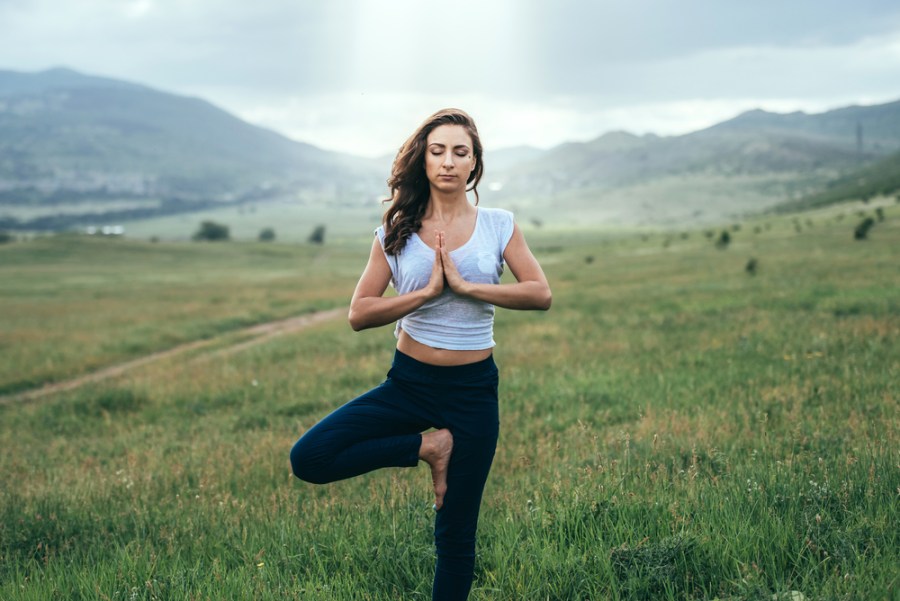Relax your mind and calm your body with these stress-soothing yoga practices from instructor Eve Boggenpoel
If you’re one of the 42 per cent of Brits who reported high levels of anxiety at the start of the third lockdown, you’ll be pleased to hear getting on your mat is a great way of bringing more calm into your life. One of the ways yoga can help is by teaching you to stay in the present, but it also has a significant physiological impact on stress levels. Research shows yoga decreases the stress hormone cortisol, lowers high blood pressure, increases relaxing alpha waves in the brain and boosts a calming neurotransmitter called gamma- aminobutyric acid (GABA). While studies show you’ll see the soothing benefits of yoga in just one session, the more you practise, the greater the effects will be, especially when it comes to lowering your baseline state of nervous arousal – meaning you’ll be less likely to react negatively to any external or internal stressors.
If you’re not sure which yoga style to focus on to reduce your anxiety, standing Iyengar postures will physically strengthen your legs and allow you to develop a stronger energetic connection to the earth, in turn increasing your sense of stability and security. To build emotional resilience and balance mind and body, try heart-opening anusara, and to help ease burnout, restorative yoga will nourish your nervous system and give you some much-needed rest. If you enjoy a flowing yoga style, a slow and gentle vinyasa session is great when you need some movement but don’t want to become too exhausted.
Work the room
To maximise the calming effects of yoga, set the scene before you begin your home practice. Consider using a soothing room spray such as Liquid Yoga or an essential oil burner with lavender or neroli. If you enjoy yin and restorative yoga, then consider investing in Holistic Silk’s Yoga Mat Rug, a soft fleece-covered mat filled with dried lavender buds. Next, put on your favourite soothing piece of music or nature sound track, spend a few moments with your eyes closed in easy or child’s pose and mindfully check in with how you feel. Are you burnt out and in need of a gentle, nurturing session? Do you feel wired and want to burn off stress? Is anxiety making you lethargic? Checking in is a very useful habit to develop pre-practice, as it lets you create a session that meets your needs.
Pick a posture
In general, forward bends will release tension in the spine, calm your mind and increase feelings of security as you’re protecting the vulnerable front area of the body. Explore the effects of poses such as child’s (arms at your sides for complete rest, extended to feel more alert), sleeping swan, seated forward fold (try crossed legs, straight legs together or wide apart, soles of your feet together, or one leg straight with the opposite heal to the groin) and see which feel right for you. Using a bolster or two for support will increase the restorative effects, and if you can rest in the postures for up to 20 minutes you’ll benefit even more. Between the forward folding postures, tune in to how you are feeling and if you need to release your body with a twist or gentle backbend, go ahead and do so.
Another beautiful way to support anxiety with yoga is to do some heart-opening postures. When we’re anxious, we often close off from others as well as ourselves in an attempt to manage our emotions. Heart-opening poses can help you develop more compassion for yourself and teach you how to sensitively take care of your needs and incorporate more self-care practices into your life. One of our favourites is reclining butterfly. Make it even more restorative by resting your spine over a bolster, placing block or pillows beneath your head and knees, and an eye pillow over your eyes, and rest in the pose for up to 20 minutes.
Take a breath
Regular pranayama sessions will supplement your anxiety-calming toolkit. Aim for breathing practices that lengthen the out-breath, as this calms your fight or flight response. Try the 7-4-8 breath (inhale for a count of seven, pause for four, exhale for eight) and practise ujjayi breathing too, as you need to narrow your throat in this technique, which helps you learn to control the speed of the out-breath.
Finally, always include savasana at the end of your practice. It will help you integrate your experience and enable you to transition into the rest of your day without losing the benefits you’ve gained on the mat. You can remain there as long as you have time for, but try to aim for a minimum of seven minutes.








